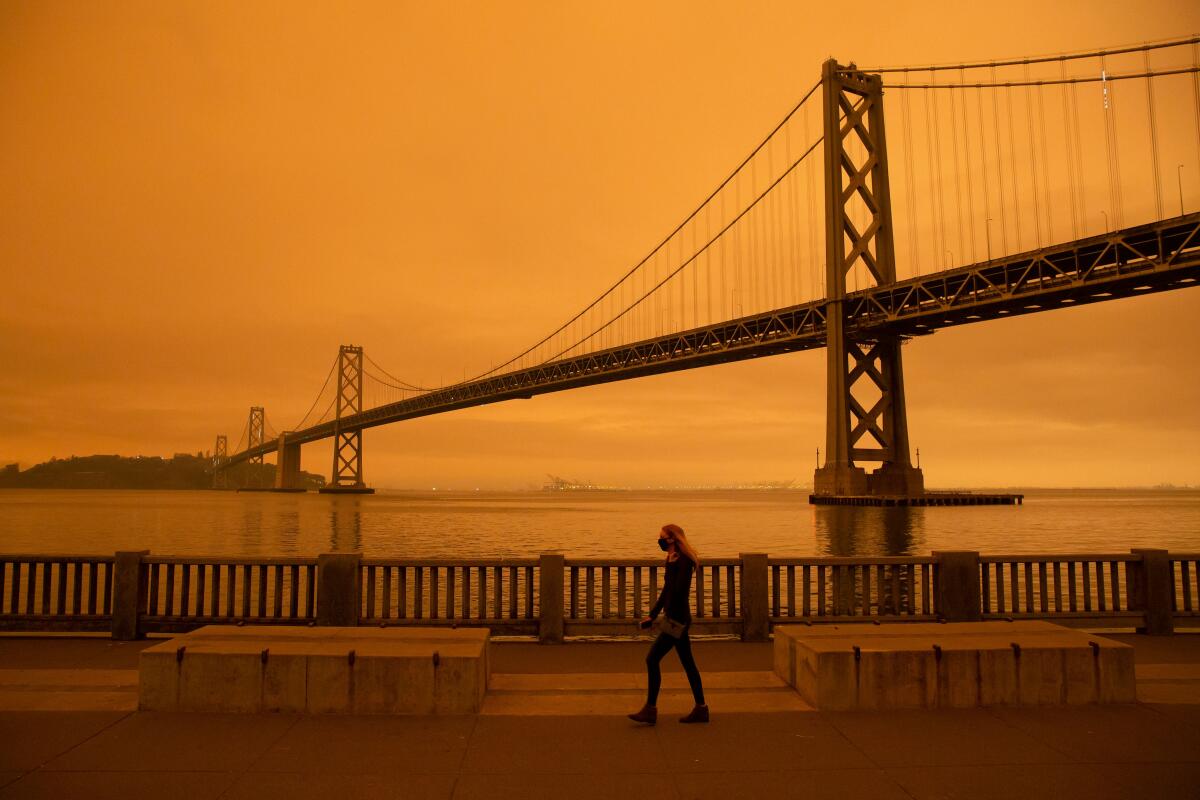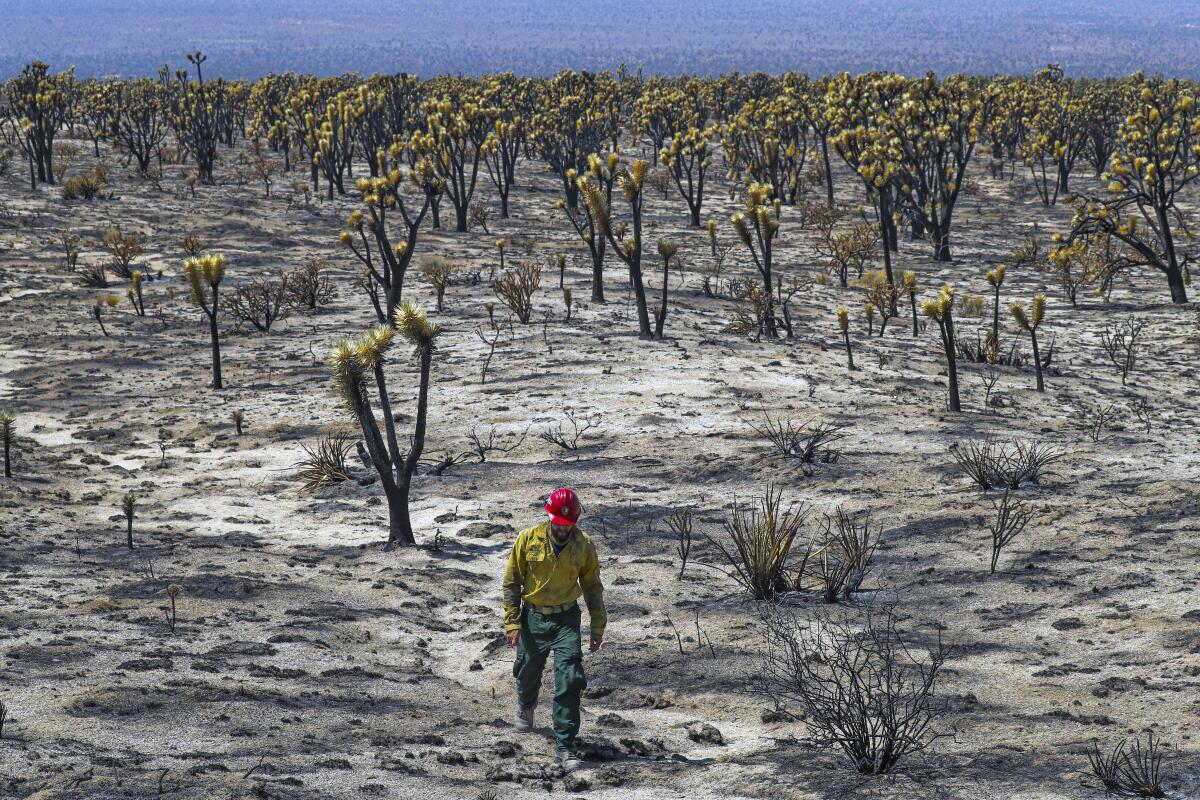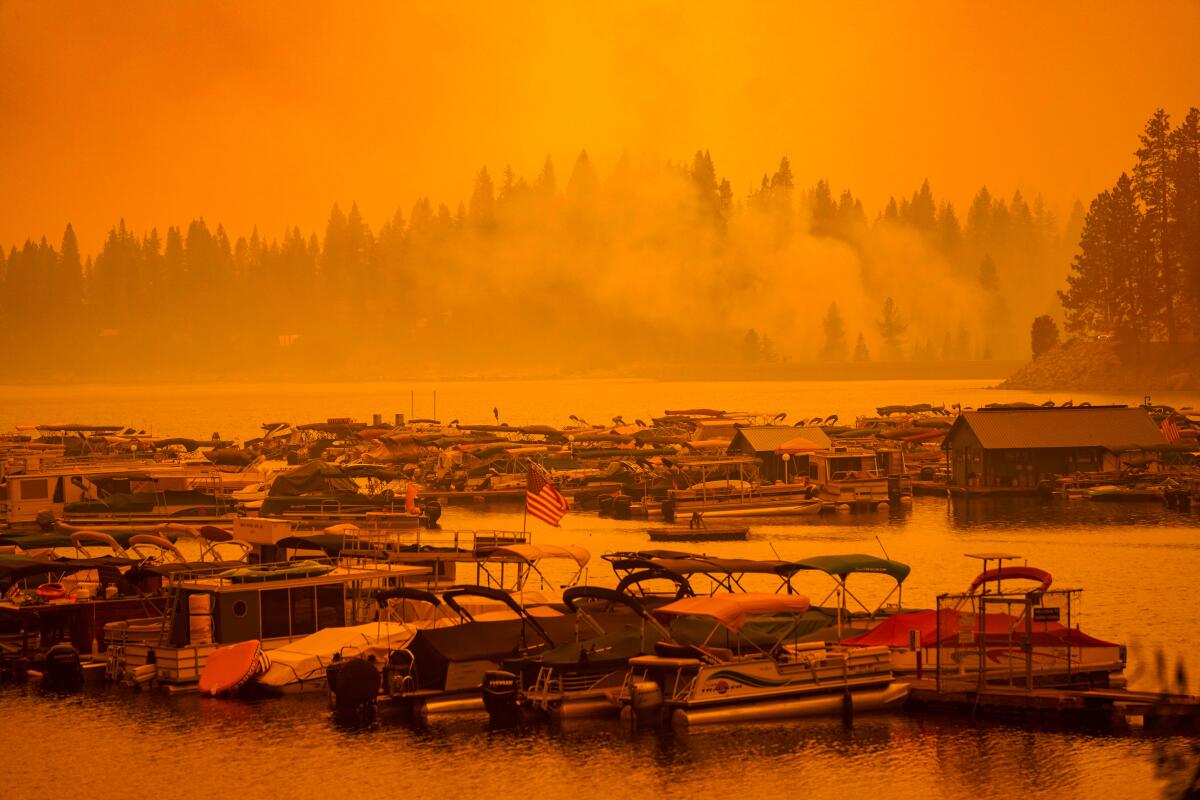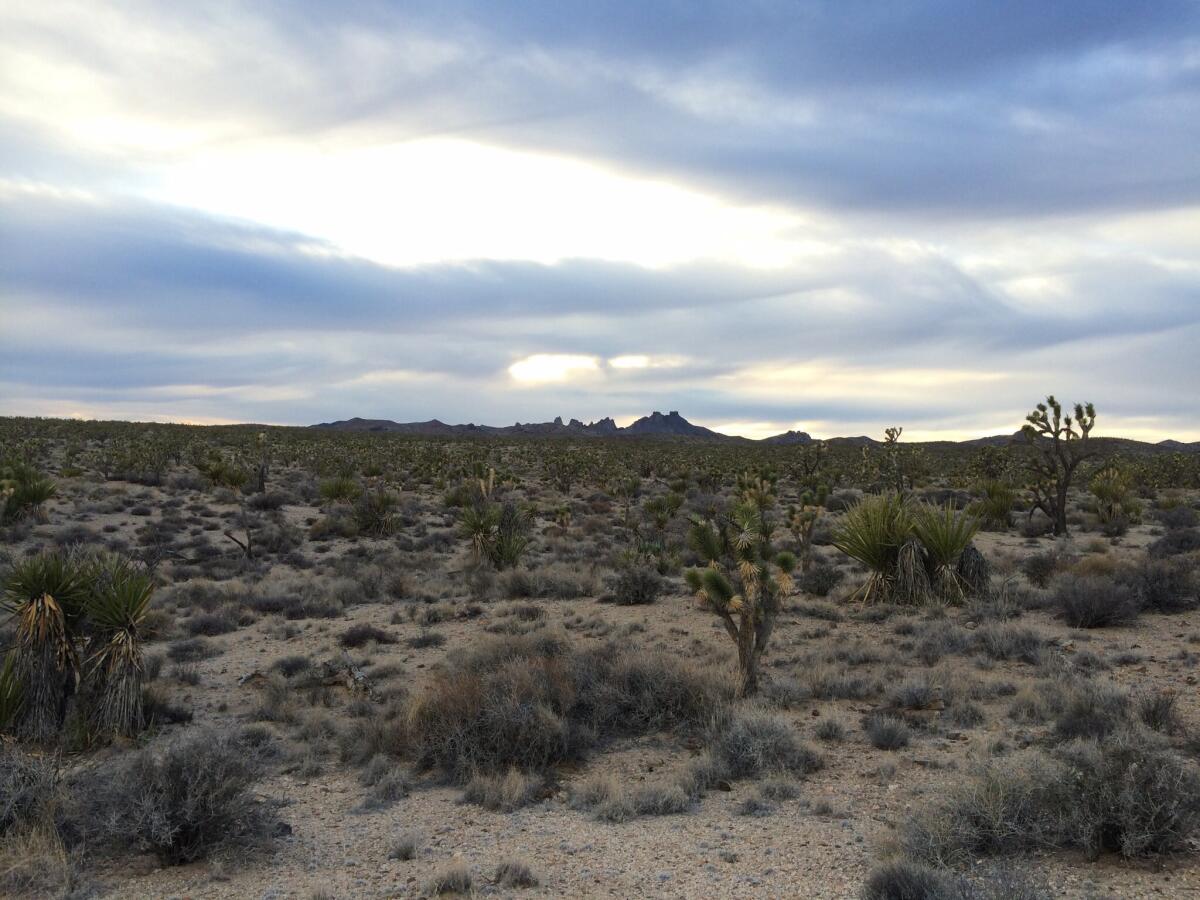Boiling Point newsletter: Climate chaos shows why the 2020 election has such high stakes

- Share via
It’s been another hellacious week in California.
Extraordinary heat. Out-of-control fires. Dangerous rescues. A faltering power grid. Ash falling from darkened, orange skies. All of it influenced by the invisible hand of climate change, by way of the greenhouse gases we pump into the atmosphere when we fill our cars with oil, burn coal and natural gas for electricity, and chop down forests.
Just three weeks ago, I wrote in this newsletter about coping with climate despair. So if you’re feeling down and looking for advice, go back and give that a read.
Today, I’m looking ahead. To November.
Toward a more sustainable California
Get Boiling Point, our newsletter exploring climate change, energy and the environment, and become part of the conversation — and the solution.
You may occasionally receive promotional content from the Los Angeles Times.
Even knowing how polarized American politics have become, it’s hard to imagine two candidates as diametrically opposed on any issue as Joe Biden and Donald Trump are on climate change.
Biden has proposed the most ambitious clean energy program ever adopted by a major-party presidential nominee. His plan includes $2 trillion in federal investments over four years, which would support renewable power, electric vehicles, sustainable agriculture and other activities that reduce emissions. Biden calls for phasing out fossil fuels for electricity generation by 2035 — a full decade ahead of California’s current target. And he highlights the potential to create millions of good-paying union jobs.
Biden’s goal is net-zero emissions by 2050, meaning the United States would emit no more planet-warming gases than it removes from the atmosphere. That’s what an international consortium of climate scientists says is necessary globally to keep Earth’s temperature from rising more than 1.5 degrees Celsius, a target set by 195 nations as part of the Paris Agreement in 2015.
For context, the ongoing chaos in California is being stoked by just 1 degree Celsius of planetary warming.
Trump, meanwhile, rejects the rock-solid science showing global warming is largely driven by fossil fuels. But the president’s personal feelings are beside the point. What matters is that he lacks any climate policy whatsoever.
A brief second-term agenda released by Trump’s reelection campaign says nothing about climate. The president’s first term has been defined by (failed) attempts to resuscitate the collapsing coal industry, and by more regulatory rollbacks designed to help the oil and gas industry than I could possibly count. (Although kudos to the New York Times, which is attempting to keep track of them all.) Trump is currently pulling the United States out of the Paris Agreement.
I often tell my family and friends that climate change is much bigger than any one election; it’s a multi-generational threat that requires decades of sustained action by America and other major economies. If Joe Biden wins the November election, he would not solve the climate crisis, any more than electing Donald Trump would mean game over.
But at this late stage in the game, four years can make a big difference.
A new report from Wood Mackenzie, a widely respected energy research firm, underscores that reality, concluding that reelecting Trump would “mark the end to any hopes” of cleaning up America’s energy sector by 2050.
That’s partly because replacing fossil fuels with solar, wind and other clean energy resources can’t happen overnight. It’s partly because any ambitious national climate program would almost certainly be held up for years in the courts.
And it’s partly because if Americans reelect Donald Trump, they’ll be sending a clear message about how they prioritize climate action, said Dan Shreve, Wood Mackenzie’s head of global wind energy research and the report’s author.
“If in fact we’re not able to get climate legislation done in the current general election, my belief is it kicks the can down the road where there’s nothing that can be done before the 2050 deadline,” Shreve told me.
“I don’t look at it as a significant technology issue, or a huge regulatory issue,” he added. “If it’s not taken care of now, within this current election, I have limited faith that in the 2024 general election, that would change.”
The report also describes the U.S. Senate, which Republicans control by a 53-47 margin, as a key climate battleground. If the GOP retains control of the Senate, “it will force a newly elected President Biden to push his climate agenda via executive order, limiting its impact to renewables development on federal lands and waters,” the report notes.
Faced with polls showing that a large majority of Americans are worried about global warming and support climate action, Trump and his appointees have made occasional gestures toward climate and the environment.
Just this week, Trump was in Florida, calling himself “the great environmentalist” and claiming he’s got the best environmental record of any president since Teddy Roosevelt, who protected 230 million acres of public lands. My colleagues Eli Stokols and Chris Megerian explained all the reasons why Trump’s claim is a distortion of reality.
Also this month, Environmental Protection Agency administrator Andrew Wheeler spoke at the Richard Nixon Presidential Library to commemorate the agency’s 50th anniversary. He pledged to clean up pollution but also claimed climate policies hurt poor people. It’s an increasingly common argument based on the idea that phasing out fossil fuels will mean higher energy prices, but it ignores the many ways rising temperatures disproportionately harm low-income families and people of color.
Biden has faced intense skepticism from climate activists too, and he’s endorsed more sweeping proposals as a result. Green New Deal supporters continue to criticize him for insisting he will not ban the oil and gas drilling technique known as fracking. They’ve also urged him not to hire former fossil fuel executives and lobbyists into his administration. He hasn’t yet made such a commitment.
So even in a Biden administration, climate activists would likely find themselves pushing and clawing for the types of policies experts say are necessary to avert the worst impacts of global warming. Remember that thing about needing to achieve net-zero emissions by 2050? The same international group of climate scientists says reaching that long-term target will require global emissions to fall 45% percent below 2010 levels by 2030. So the next decade matters, a lot.
But even if Biden’s plans are no panacea, the Wood Mackenzie report shows what a dramatic impact they would have.
To reach 100% clean power by 2035, the U.S. would need a seven-fold expansion of solar and onshore wind turbines, “coupled with hockey-stick growth in offshore wind and battery sectors,” the research firm says. The report forecasts $2.2 trillion in clean power investments that could “produce a new generation of energy majors,” upending the dominance of today’s oil and gas giants.
“This is an aspirational plan, but achievable,” Shreve said. “It’s teetering right there on that line.”
As a journalist, I’d much rather write about two presidential candidates offering competing visions for tackling climate change. It would be invigorating for me to explore the benefits and drawbacks of each approach.
Unfortunately, we don’t live in that reality. We live in a reality where one candidate has a plan to address the crisis fueling deadlier heat storms and wildfires, and the other one does not.
Here’s what else is happening around the West:
TOP STORIES

“A drive down Cima Road that only weeks ago was a trip through a magical landscape is now a tour of the world’s biggest Joshua tree graveyard.” My colleague Bettina Boxall wrote about the vicious fire that tore through Mojave National Preserve, decimating an iconic desert species. Global warming is part of the story, but Bettina also writes about the harm caused by invasive grasses — and the area’s history of cattle grazing, which may have made this beloved Joshua tree forest unnaturally dense.
How is climate change affecting California’s wine country? Times columnist Steve Lopez traveled to the vineyards north of the San Francisco Bay to investigate, and came away with the grim understanding that many of the state’s best-loved grapes — including cabernet sauvignon — will no longer be viable in many of the places they are currently grown. But he reports that some winemakers are adapting, experimenting with new types of grapes that might be better suited for the changing climate.
Does California need fossil fuels to keep the lights on? That question was subject to much debate after last month’s rolling blackouts, and again after this weekend’s near-miss. I spoke with the CEO of the state’s power grid operator, who told me he doesn’t think we necessarily need gas plants long-term — as long as we build the right types of clean energy infrastructure.
CALIFORNIA BURNING
We’ve published so many gut-wrenching fire stories that I hardly know where to begin. My colleagues Thomas Curwen and Harriet Ryan wrote about the Sierra Nevada residents who fled as the Creek fire “exploded into a monster inferno.” Brittny Mejia wrote about hikers on the John Muir Trail evacuated by military helicopters, and Alex Wigglesworth chronicled an even more dramatic rescue. Deborah Netburn wrote about potentially toxic ash raining from the sky in the Los Angeles Basin. The U.S. Forest Service shut down all forests statewide. Bay Area residents awoke Wednesday to an orange sky that made day feel like night.

A record 2.5 million acres have burned in California this year, and it will only get worse. Statewide, 28 major fires have forced 64,000 people to evacuate, and strong winds — the much-feared Santa Anas in the south and Diablos in the north — are only now arriving. The North Complex fire menaces the still hardly rebuilt town of Paradise. The Bobcat fire in the Angeles National Forest is threatening the San Gabriel Valley and making Southern California’s air even more unhealthy than usual. And if all that’s not bad enough, Pacific Gas & Electric shut off power to 172,000 customers to prevent its infrastructure from igniting more fires.
And oh yeah, it’s been hotter than ever. Los Angeles County set an all-time record with a 121-degree high in Woodland Hills over the weekend. A 120-degree reading in San Luis Obispo may have been the hottest temperature on record for any place so close to an ocean in the Americas. The Times’ Tony Barboza wrote about how the health impacts of hot weather are getting worse with climate change, noting that more Americans are killed by extreme heat each year than by all floods and storms combined.
Enjoying this newsletter? Consider subscribing to The Times
Your support helps us deliver the news that matters most, and makes newsletters like Boiling Point possible. Become a Los Angeles Times subscriber.
POWER STRUGGLES
Let’s return to the Trump administration for a minute. My Washington, D.C.-based colleagues Anna M. Phillips and Del Quentin Wilbur report that the White House is telling environmental regulators and other federal agencies to relax enforcement of all sorts of laws and regulations. How are they supposed to do that, exactly? By not opening multiple investigations into the same company, keeping investigations short and seeking approval from political appointees before moving forward with an inquiry.
California Gov. Gavin Newsom thought he could save the bullet train by downsizing it. But even Newsom’s plan for a $20.4-billion high-speed rail corridor through the Central Valley is looking less and less viable, The Times’ Ralph Vartabedian reports. Revenues have fallen off a cliff, contractors are demanding hundreds of millions of dollars to cover rising costs, and officials have documented dozens of “critical” problems that could delay the bullet train’s opening past its 2028 target date. Here’s hoping the people in charge get their act together; high-speed rail would be a useful clean transportation alternative to cars and planes.
There’s growing interest in energy circles around renewable hydrogen, a still-expensive fuel that could play a major role in replacing natural gas if costs come down. I wrote last year about Los Angeles’s effort to build the world’s first power plant that runs on hydrogen; now the Wall Street Journal’s Katherine Blunt reports that other utilities are getting started on pilot projects.
AROUND THE WEST

Tribes and conservationists are seeking a new national monument in Southern Nevada to protect sacred landscapes surrounding Spirit Mountain, the world’s biggest Joshua tree and the historic Walking Box Ranch. The Reno Gazette Journal’s Amy Alonzo wrote about the proposed Avi Kwa Ame National Monument, which would connect several protected areas in California and Nevada. I was lucky enough to visit the neighboring Castle Mountains a few years ago; they’re totally gorgeous.
There was drama on the Colorado River this week as Arizona approved a controversial farm-to-city water transfer. Here’s the story from the Arizona Republic’s Ian James, who notes that critics worry this deal could set a precedent across the watershed. Ian also reports that six of the seven Colorado River Basin states, including California, are urging the federal government not to approve a Utah pipeline project that would bring water from the already over-tapped river to the rapidly growing St. George area.
In Point Reyes, a local radio station is keeping people informed about fires and coronavirus. I’m a sucker for a good story about local media, and this piece by The Times’ Anita Chabria delivers, chronicling the invaluable work of two employees and a network of volunteers at KWMR. They’ll tell listeners when to evacuate and can keep them entertained in the meantime.
What do you want to know?
When you think about California’s climate future, what comes to mind? What keeps you up at night, and what gives you hope or gets you excited? What do you want to understand, and what should I?
This newsletter is for you, to help you understand how we’re changing our world and what we can do about it, and I want to hear your questions, concerns and ideas. Email me or find me on Twitter.
ONE MORE THING
A bright spot amid this weekend’s heat wave: Whoever operates Dodger Stadium’s left field video board has a sense of humor.
I’ll be back in your inbox next week. If you enjoyed this newsletter, please consider forwarding it to your friends and colleagues.




